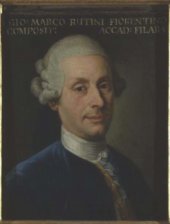Born in Florence in April 1723 his musical formation was completed at the Neapolitan Conservatory “Pietà dei Turchini” where he studied composition under Leo, harpsichord with Fago and violin with Pagliarulo. After terminating his studies he was employed as an under-maestro and shortly after 1744 returned to Florence. His early years were characterised by frequent moves: he certainly spent some time in 1748 in Prague where he finished his sonatas for harpsichord Op.1, and again in 1753 on the occasion of the first performance of his first opera Semiramide. In the years between 1754 and 1756 he lived in Berlin and Dresden and two years later at St Petersburg where he produced his first comedy Il negligente, and also where he was a substitute maestro in Locatelli’s company. In the Russian city he was favourably received by the high society, so much so that he became the future Catherine II’s harpsichord teacher and a favourite of Count Sheremetev who employed him as the conductor and director of his private orchestra. He was elected member of the Philharmonic Academy in 1761 and settled definitively in Florence where he concentrated on the composition of operas. In all, he wrote about fourteen, some of which were extremely successful – as is the case of I matrimoni in maschera, which in the year 1763 alone, was performed in the cities of Cremona, Bologna, Florence, Madrid, Dresden and Copenhagen. Following the success of Nitteti, he was nominated to the position of kappelmeister for the Duke of Modena but continued living in Florence as he hoped to receive the same position from Grand Duke Leopold to whom he had dedicated his Sonatas for Harpsichord Op. 8. He died in Florence in 1797 after having dedicated his later years to the composition of sacred music. The historical importance of this composer can be expressed in terms of his output for keyboard, and together with the Neapolitan Mattia Vento, he can be considered as one of the protagonists of the harpsichord sonata of the second half of the eighteenth century. His work can be divided into two principal groups. In his earlier compositions Rutini appears as a harmonic experimenter, often using dissonances and transitional modulations – also as an innovator of keyboard technique in that he divided the virtuosity equally between the left and right hands. The general strucuture of his sonatas in the fairly standard three movement form which includes a two themed allegro in three parts and a minuet both with or without the trio. One hears a musical style influenced by the “galant” climate with its pastoral inclinations, but Rutini achieving a such a superiority of technique over many compositions of this style, gives the idea of maintaining a distance which seems to suggest almost a parody . The second phase is characterised by a surprising stylistic conversion, particularly from his Op. 8 of 1774 onwards. At the end of this last work he writes, “The harpsichord…being useful and entertaining company and can with reason consider itself as being one of the lightest ornaments to be included in one’s education.[…]I have tried insofar as I have been able to, to render these sonatas easy, clear, lacking in those difficulties which confuse rather than delight…” The sonata abandons the extreme virtuosity of the period and gives way to the “sonatina”, a composition dedicated to the aims of teaching and recreation and which permits even less expert players to arrive at pleasurable and gratifying results. Apart some purely formal novelties, Rutini had reached the end of his creative road and expressed the impossibility of his surpassing his previous results.
Vocal Music
"Ezio", dramma per musica










